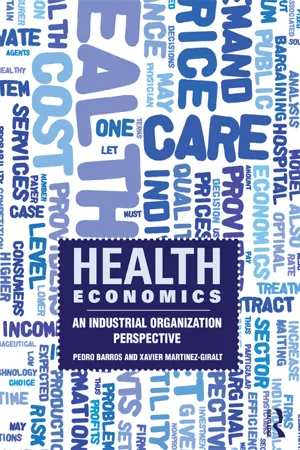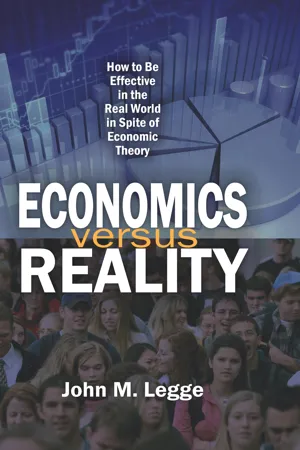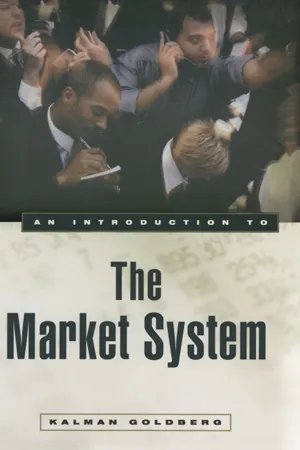Economics
Perfectly Competitive Market
A perfectly competitive market is a theoretical model in which numerous small firms produce identical products and have no market power. In this market structure, there are no barriers to entry or exit, and all firms are price takers. Prices are determined by the forces of supply and demand, and economic profits are driven to zero in the long run.
Written by Perlego with AI-assistance
Related key terms
6 Key excerpts on "Perfectly Competitive Market"
- eBook - ePub
Health Economics
An Industrial Organization Perspective
- Xavier Martinez-Giralt, Pedro Barros(Authors)
- 2013(Publication Date)
- Routledge(Publisher)
24.1 The Perfectly Competitive Market
A Perfectly Competitive Market is characterized by a large number of buyers and sellers, so that none of them has the capacity to affect the market price at which transactions take place. There are very few markets in the real economies that fit in this pattern, however there are several reasons that justify its study. On the one hand, it is a market with a simple functioning mechanism that can be used as a reference to elaborate more complex models closer to real situations. On the other hand, the equilibrium of a Perfectly Competitive Market (that is, the market price and the market allocation) shows two important properties: the allocation obtained is efficient i.e. is the best possible allocation of resources, and this equilibrium does not need any intervention from a public authority. To be precise, we first present the assumptions of the model and then will characterize the equilibrium.4.1.1 Assumptions
The model of perfect competition is based on eight assumptions fully characterizing the framework where the agents take their decisions and their behavior.Structural assumptions
ASSUMPTION 4.1 The model is static and of partial equilibrium.This assumption means that the analysis does not contemplate a temporal dimension. Instead, all agents make their decisions at the same time without being able to transfer goods and services either from the past to the present, or from the present to the future. Also, the model only studies the market for a single commodity. Thus, no potential interactions among different goods and services are included in the decision-making process of the agents. In plain words, this set-up considers very simple agents only aware of the present and able to take decisions only on a single product. - eBook - ePub
Microeconomics
A Global Text
- Judy Whitehead(Author)
- 2014(Publication Date)
- Routledge(Publisher)
9 The Perfectly Competitive MarketEquilibrium of the Firm and Industry in Short-run and Long-run ; Perfect Competition and Economic Efficiency ; Industry Dynamics: Changes in Demand, Costs and Taxes .The market structure of Perfect Competition is often considered a highly desirable one particularly from the point of view of economic efficiency in a static, distributive sense. This is in consonance with the view that trading in increasingly competitive markets is, in theory, beneficial to economic welfare because of the greater efficiency in the use of economic resources. While this may or may not hold true in reality, it is nevertheless of importance to understand the intricacies and mechanics of this model which has received so much attention.Perfect Competition is the centrepiece of the traditional theory of the firm. It is one of the four basic models of market structure that make up the traditional theory of the firm. The others are Monopoly, Monopolistic Competition and Oligopoly. As a model of market structure, it is used to explain and predict the behaviour of firms which are part of this industry. Furthermore, as one of the so-called ‘marginalist’ models of the firm, the firm is theorized to maximize profits by following the ‘marginalist’ rule of equating marginal revenue with marginal cost.These marginalist models are later contrasted with the more modern alternative models of the firm which are included in the study of market structure. Newer models have proliferated since the 1930 and particularly since the 1950s and include the Managerial, Behavioural, Average-cost/Mark-up Pricing and Entry-Prevention models.9.1 Assumptions and Fundamentals of the Model
9.1.1 Basic assumptions
The basic assumptions of the model of Perfect Competition are as follows:- There are many buyers and sellers (firms) in the industry. There are so many buyers and sellers that no single buyer or seller can influence price or output sufficiently to alter the equilibrium of the industry.
- eBook - ePub
Economics versus Reality
How to be Effective in the Real World in Spite of Economic Theory
- John M Legge(Author)
- 2017(Publication Date)
- Routledge(Publisher)
Nineteenth-century mechanical engineers designing steam engines knew that real steam would not pass instantaneously from the boiler to the cylinder as soon as the valves were opened; even an ideal gas would have some inertia and consequent “Newtonian” viscosity, which would limit the speed at which it could travel. At the piston speed typical of late-nineteenth-century engines, the discrepancy was minor, although neglecting or miscalculating these effects often led to designs for engines that failed to meet their specifications. Engineers soon learned the risks involved in assuming perfection while dealing with the real world. These lessons were slow to pass to economists.Perfect competition is a theoretical state in which an economy, or part of an economy, may exist on the assumption that consumers and producers behave like a frictionless, weightless ideal gas: if producer A offers a lower price than producer B, every consumer will instantaneously transfer their business from A to B, no matter how small the price differential. This is known to economists as the Law of One Price, and as such is part of the dogmatic core of the theory of perfect competition. Industrial Organization (IO) economists, as discussed further below, do not consider that perfect competition exists in reality, although they tread fairly carefully around the Law of One Price.Orwell, in his book 1984, suggested that control of language could become control of thought. The economic concept of perfect competition is an example of this: if there is such a thing as perfection, why should anything else be tolerated? Some economists may believe that perfect competition is a practical possibility; others realize that the preconditions for perfect competition are so stringent as to render it impossible to actually exist as a practical matter of commerce.The best that can be hoped for is “nearly perfect” competition, whatever that may be. J. M. Clark introduced the idea of “workable competition” in 1940.3 “Workable” competition is defined as the closest practical approach to “perfect” competition, recognizing that there aren’t an infinite number of firms or consumers and that all products are not fully interchangeable. Clark’s proposal does not seem to have satisfied the generality of economists. S. H. Sosnick published a critique of workable competition in 1958,4 - eBook - ePub
- Israel M Kirzner(Author)
- 2002(Publication Date)
- Routledge(Publisher)
The model presumes satisfaction of a series of conditions which together assure a pattern of decisions by market participants insulated from the possibility of disappointment or regret. No decision to buy or to sell can fail to be accepted in this model. Nor can hindsight ever reveal to any buyer or seller that a more attractive market opportunity has been missed. Each potential buyer (seller) correctly anticipates the lowest (highest) price available in the market, and, moreover, correctly expects to be able to buy (sell) as much as he wishes to buy (sell) at this price. The price which all market participants correctly anticipate is that price which, when indeed anticipated by all, inspires the decisions to buy and sell which dovetail completely. It is not merely that the buying and selling decisions so made do indeed mesh perfectly; it is, in addition to such “pre-reconciliation of plans,” 7 that the sets of expectations underlying and inspiring each of these plans have somehow come to correctly and mutually anticipate what each of the other plans will in fact bring about. In fact, the perfection of knowledge underlying the model is, ultimately, more than simply the correct anticipation by each participant of the actions of others; it involves, in the final analysis, the correct and self-fulfilling anticipation by each of the (correct and self-fulfilling) anticipations by each of the others, of the (correct and self-fulfilling) anticipations, et cetera, et cetera, ad infinitum. To put the matter concisely, the perfectly competitive model portrays (as does each and every equilibrium model of a market) a pattern of mutual anticipations and executed decisions which, if somehow attained, would lead no participant to wish that he had acted differently - William Byrd(Author)
- 2019(Publication Date)
- Routledge(Publisher)
Competition can be classified by several different criteria: (1) the number of transactors on each side of the market and the impact each has on the market; (2) actual versus potential competition; (3) the arena in which competition occurs (price versus nonprice competition, business competition versus competition for rents); and (4) general market conditions (buyers’ market versus sellers’ market). The last of these is discussed in the following section.At one extreme, monopoly in theory results in restriction of output and higher prices. At the opposite extreme, perfect competition has strong static efficiency implications. The combination of the two is monopolistic competition (Chamberlin 1956), where each producer has a unique product for which he is a monopolist facing a downward-sloping demand curve, but there are many sellers of similar goods, each too small to affect market conditions for the “product group” as a whole. In between the two extremes are various forms of imperfect competition, with relatively few transactors, at least some of them of a size large enough that they individually can have an impact on prices, market conditions, and each others’ activities.Even if the number of market participants is small, as long as entry is relatively easy and unrestricted they may compete as if their number were larger. To have meaningful potential competition, the threat of new entrants must be credible to market participants. Various kinds of barriers to entry then become important. Some may be technical or “natural”; others are erected by market participants to deter entry and allow them higher profits or an easier life; still others are created by the government, either in its own interest or at the behest of market participants. Potential competition from prospective entrants is important because it may support dynamic markets even if the number of actual transactors is very small.Nonprice competition is more important than price competition in many markets. This encompasses product characteristics, design, and usefulness; product quality; advertising; location, convenience, and availability; and postsale service and warranties. Product differentiation can be beneficial for consumers, because it is valued in itself or because consumers with different tastes have different preferences. Similarly, product variation for intermediate and capital goods may have similar benefits for users.- eBook - ePub
- Kalman Goldberg(Author)
- 2016(Publication Date)
- Routledge(Publisher)
The market system’s response to scarcity has succeeded. It has indeed expanded the range of human satisfaction for those fortunate enough to be able to take an active part in it. However, in the process, the institutions, behavior, and circumstances that were prerequisite to the system have changed. Indeed, the market system model has now become the paradigm for formerly command and traditional economies. Each of them, as they develop industrially, will adapt their own institutions and values to fashion a wide range of individualized versions of the model, just as the Western world countries have done.Thus, it is critically important to remember that this Perfectly Competitive Market analysis is founded on conditions that are perfect to a degree never attained in any economy. Competition has rarely, if ever, existed as we have described it in this chapter; highly industrialized, urbanized, unionized institutions, particularly, do not lend themselves to the refined operations of the Perfectly Competitive Market system. However, the analysis is nonetheless valuable because our modern economic society and most of the societies of the world are patterned after the one described by the perfectly competitive model, with important reliance on the price mechanism. Because of our attitudes about what kind of system is “good” and “right,” our ideological commitments, are also fashioned out of the neoclassical mold, and because many of our current economic policies are based on these normative goals.SummaryThe solutions to the How and For Whom to produce problems are both made through the forces of demand and supply in the factor markets in the neoclassical market system. The example of the labor market illustrates key demand relationships of the perfectly competitive firm in the labor market.The marginal revenue product (MRP) curve is the firm’s demand curve for labor. It slopes downward and to the right because with additions to the work force, marginal product (and, therefore, MRP) declines.
Learn about this page
Index pages curate the most relevant extracts from our library of academic textbooks. They’ve been created using an in-house natural language model (NLM), each adding context and meaning to key research topics.





